display CHEVROLET CORVETTE 2020 Workshop Manual
[x] Cancel search | Manufacturer: CHEVROLET, Model Year: 2020, Model line: CORVETTE, Model: CHEVROLET CORVETTE 2020Pages: 336, PDF Size: 5.21 MB
Page 142 of 336
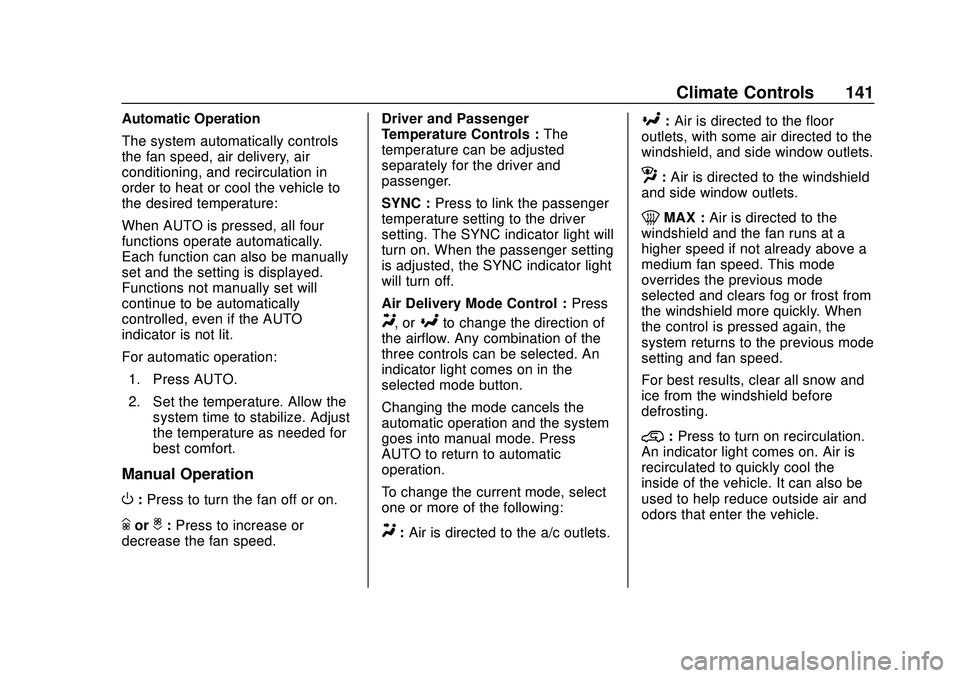
Chevrolet Corvette Owner Manual (GMNA-Localizing-U.S./Canada/Mexico-
12470550) - 2020 - CRC - 4/23/20
Climate Controls 141
Automatic Operation
The system automatically controls
the fan speed, air delivery, air
conditioning, and recirculation in
order to heat or cool the vehicle to
the desired temperature:
When AUTO is pressed, all four
functions operate automatically.
Each function can also be manually
set and the setting is displayed.
Functions not manually set will
continue to be automatically
controlled, even if the AUTO
indicator is not lit.
For automatic operation:1. Press AUTO.
2. Set the temperature. Allow the system time to stabilize. Adjust
the temperature as needed for
best comfort.
Manual Operation
O:Press to turn the fan off or on.
hori: Press to increase or
decrease the fan speed. Driver and Passenger
Temperature Controls :
The
temperature can be adjusted
separately for the driver and
passenger.
SYNC : Press to link the passenger
temperature setting to the driver
setting. The SYNC indicator light will
turn on. When the passenger setting
is adjusted, the SYNC indicator light
will turn off.
Air Delivery Mode Control : Press
Y, or[to change the direction of
the airflow. Any combination of the
three controls can be selected. An
indicator light comes on in the
selected mode button.
Changing the mode cancels the
automatic operation and the system
goes into manual mode. Press
AUTO to return to automatic
operation.
To change the current mode, select
one or more of the following:
Y: Air is directed to the a/c outlets.
[:Air is directed to the floor
outlets, with some air directed to the
windshield, and side window outlets.
z: Air is directed to the windshield
and side window outlets.
0MAX : Air is directed to the
windshield and the fan runs at a
higher speed if not already above a
medium fan speed. This mode
overrides the previous mode
selected and clears fog or frost from
the windshield more quickly. When
the control is pressed again, the
system returns to the previous mode
setting and fan speed.
For best results, clear all snow and
ice from the windshield before
defrosting.
@: Press to turn on recirculation.
An indicator light comes on. Air is
recirculated to quickly cool the
inside of the vehicle. It can also be
used to help reduce outside air and
odors that enter the vehicle.
Page 150 of 336
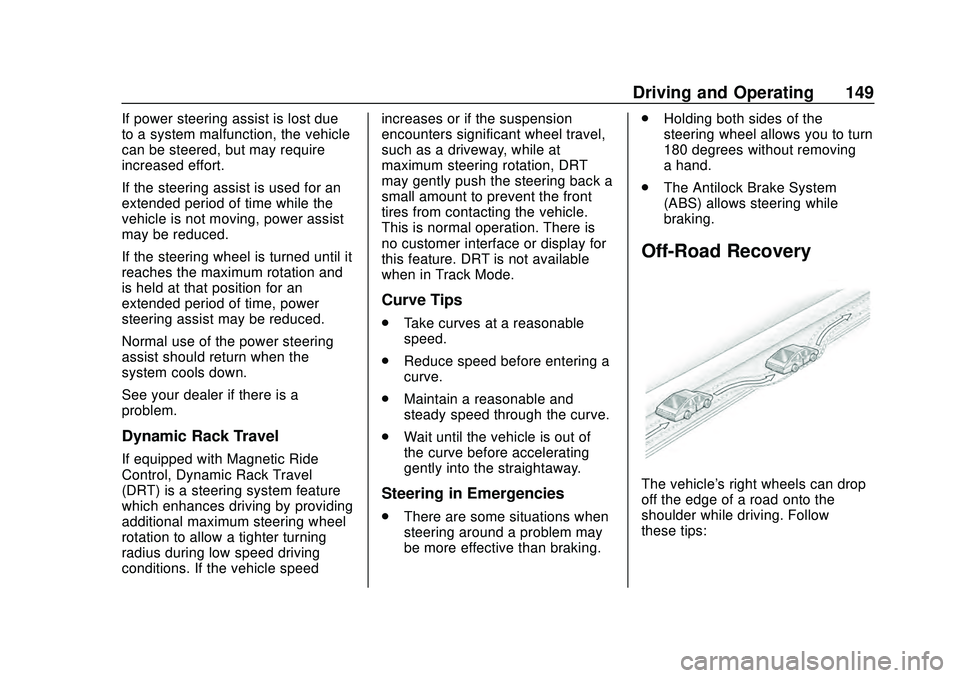
Chevrolet Corvette Owner Manual (GMNA-Localizing-U.S./Canada/Mexico-
12470550) - 2020 - CRC - 4/23/20
Driving and Operating 149
If power steering assist is lost due
to a system malfunction, the vehicle
can be steered, but may require
increased effort.
If the steering assist is used for an
extended period of time while the
vehicle is not moving, power assist
may be reduced.
If the steering wheel is turned until it
reaches the maximum rotation and
is held at that position for an
extended period of time, power
steering assist may be reduced.
Normal use of the power steering
assist should return when the
system cools down.
See your dealer if there is a
problem.
Dynamic Rack Travel
If equipped with Magnetic Ride
Control, Dynamic Rack Travel
(DRT) is a steering system feature
which enhances driving by providing
additional maximum steering wheel
rotation to allow a tighter turning
radius during low speed driving
conditions. If the vehicle speedincreases or if the suspension
encounters significant wheel travel,
such as a driveway, while at
maximum steering rotation, DRT
may gently push the steering back a
small amount to prevent the front
tires from contacting the vehicle.
This is normal operation. There is
no customer interface or display for
this feature. DRT is not available
when in Track Mode.
Curve Tips
.
Take curves at a reasonable
speed.
. Reduce speed before entering a
curve.
. Maintain a reasonable and
steady speed through the curve.
. Wait until the vehicle is out of
the curve before accelerating
gently into the straightaway.
Steering in Emergencies
.
There are some situations when
steering around a problem may
be more effective than braking. .
Holding both sides of the
steering wheel allows you to turn
180 degrees without removing
a hand.
. The Antilock Brake System
(ABS) allows steering while
braking.
Off-Road Recovery
The vehicle's right wheels can drop
off the edge of a road onto the
shoulder while driving. Follow
these tips:
Page 153 of 336
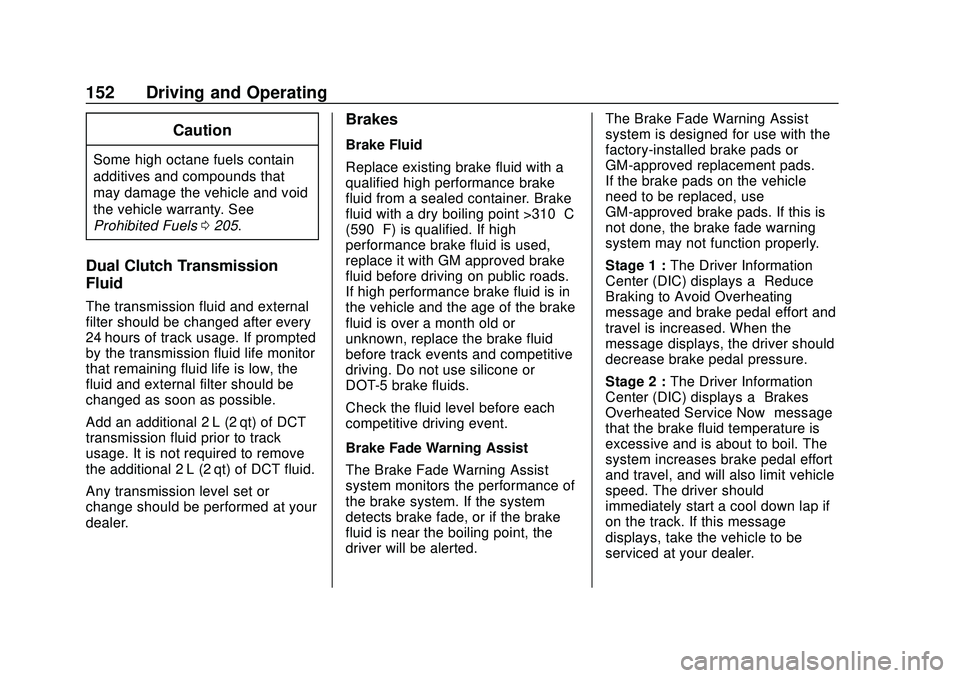
Chevrolet Corvette Owner Manual (GMNA-Localizing-U.S./Canada/Mexico-
12470550) - 2020 - CRC - 4/23/20
152 Driving and Operating
Caution
Some high octane fuels contain
additives and compounds that
may damage the vehicle and void
the vehicle warranty. See
Prohibited Fuels0205.
Dual Clutch Transmission
Fluid
The transmission fluid and external
filter should be changed after every
24 hours of track usage. If prompted
by the transmission fluid life monitor
that remaining fluid life is low, the
fluid and external filter should be
changed as soon as possible.
Add an additional 2 L (2 qt) of DCT
transmission fluid prior to track
usage. It is not required to remove
the additional 2 L (2 qt) of DCT fluid.
Any transmission level set or
change should be performed at your
dealer.
Brakes
Brake Fluid
Replace existing brake fluid with a
qualified high performance brake
fluid from a sealed container. Brake
fluid with a dry boiling point >310 °C
(590 °F) is qualified. If high
performance brake fluid is used,
replace it with GM approved brake
fluid before driving on public roads.
If high performance brake fluid is in
the vehicle and the age of the brake
fluid is over a month old or
unknown, replace the brake fluid
before track events and competitive
driving. Do not use silicone or
DOT-5 brake fluids.
Check the fluid level before each
competitive driving event.
Brake Fade Warning Assist
The Brake Fade Warning Assist
system monitors the performance of
the brake system. If the system
detects brake fade, or if the brake
fluid is near the boiling point, the
driver will be alerted. The Brake Fade Warning Assist
system is designed for use with the
factory-installed brake pads or
GM-approved replacement pads.
If the brake pads on the vehicle
need to be replaced, use
GM-approved brake pads. If this is
not done, the brake fade warning
system may not function properly.
Stage 1 :
The Driver Information
Center (DIC) displays a “Reduce
Braking to Avoid Overheating”
message and brake pedal effort and
travel is increased. When the
message displays, the driver should
decrease brake pedal pressure.
Stage 2 : The Driver Information
Center (DIC) displays a “Brakes
Overheated Service Now” message
that the brake fluid temperature is
excessive and is about to boil. The
system increases brake pedal effort
and travel, and will also limit vehicle
speed. The driver should
immediately start a cool down lap if
on the track. If this message
displays, take the vehicle to be
serviced at your dealer.
Page 166 of 336
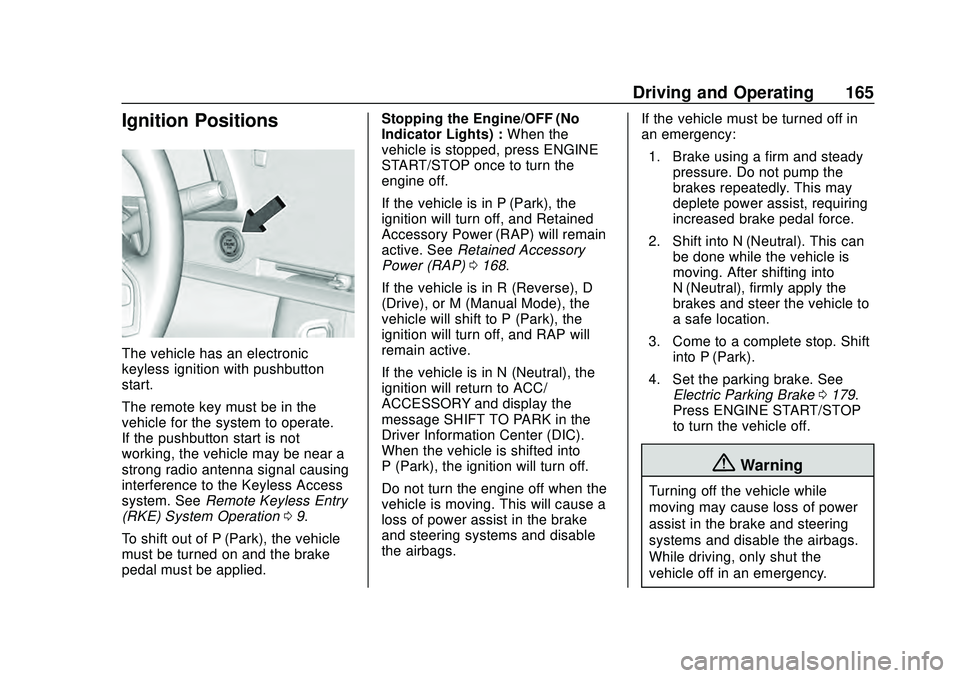
Chevrolet Corvette Owner Manual (GMNA-Localizing-U.S./Canada/Mexico-
12470550) - 2020 - CRC - 4/23/20
Driving and Operating 165
Ignition Positions
The vehicle has an electronic
keyless ignition with pushbutton
start.
The remote key must be in the
vehicle for the system to operate.
If the pushbutton start is not
working, the vehicle may be near a
strong radio antenna signal causing
interference to the Keyless Access
system. SeeRemote Keyless Entry
(RKE) System Operation 09.
To shift out of P (Park), the vehicle
must be turned on and the brake
pedal must be applied. Stopping the Engine/OFF (No
Indicator Lights) :
When the
vehicle is stopped, press ENGINE
START/STOP once to turn the
engine off.
If the vehicle is in P (Park), the
ignition will turn off, and Retained
Accessory Power (RAP) will remain
active. See Retained Accessory
Power (RAP) 0168.
If the vehicle is in R (Reverse), D
(Drive), or M (Manual Mode), the
vehicle will shift to P (Park), the
ignition will turn off, and RAP will
remain active.
If the vehicle is in N (Neutral), the
ignition will return to ACC/
ACCESSORY and display the
message SHIFT TO PARK in the
Driver Information Center (DIC).
When the vehicle is shifted into
P (Park), the ignition will turn off.
Do not turn the engine off when the
vehicle is moving. This will cause a
loss of power assist in the brake
and steering systems and disable
the airbags. If the vehicle must be turned off in
an emergency:
1. Brake using a firm and steady pressure. Do not pump the
brakes repeatedly. This may
deplete power assist, requiring
increased brake pedal force.
2. Shift into N (Neutral). This can be done while the vehicle is
moving. After shifting into
N (Neutral), firmly apply the
brakes and steer the vehicle to
a safe location.
3. Come to a complete stop. Shift into P (Park).
4. Set the parking brake. See Electric Parking Brake 0179.
Press ENGINE START/STOP
to turn the vehicle off.
{Warning
Turning off the vehicle while
moving may cause loss of power
assist in the brake and steering
systems and disable the airbags.
While driving, only shut the
vehicle off in an emergency.
Page 168 of 336
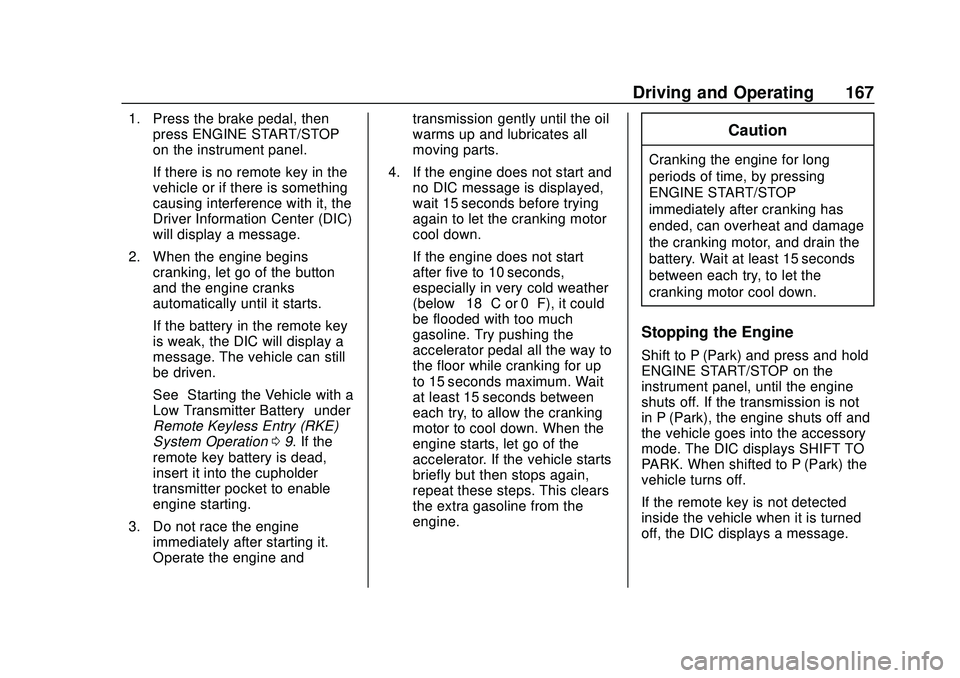
Chevrolet Corvette Owner Manual (GMNA-Localizing-U.S./Canada/Mexico-
12470550) - 2020 - CRC - 4/23/20
Driving and Operating 167
1. Press the brake pedal, thenpress ENGINE START/STOP
on the instrument panel.
If there is no remote key in the
vehicle or if there is something
causing interference with it, the
Driver Information Center (DIC)
will display a message.
2. When the engine begins cranking, let go of the button
and the engine cranks
automatically until it starts.
If the battery in the remote key
is weak, the DIC will display a
message. The vehicle can still
be driven.
See “Starting the Vehicle with a
Low Transmitter Battery” under
Remote Keyless Entry (RKE)
System Operation 09. If the
remote key battery is dead,
insert it into the cupholder
transmitter pocket to enable
engine starting.
3. Do not race the engine immediately after starting it.
Operate the engine and transmission gently until the oil
warms up and lubricates all
moving parts.
4. If the engine does not start and no DIC message is displayed,
wait 15 seconds before trying
again to let the cranking motor
cool down.
If the engine does not start
after five to 10 seconds,
especially in very cold weather
(below −18 °C or 0 °F), it could
be flooded with too much
gasoline. Try pushing the
accelerator pedal all the way to
the floor while cranking for up
to 15 seconds maximum. Wait
at least 15 seconds between
each try, to allow the cranking
motor to cool down. When the
engine starts, let go of the
accelerator. If the vehicle starts
briefly but then stops again,
repeat these steps. This clears
the extra gasoline from the
engine.Caution
Cranking the engine for long
periods of time, by pressing
ENGINE START/STOP
immediately after cranking has
ended, can overheat and damage
the cranking motor, and drain the
battery. Wait at least 15 seconds
between each try, to let the
cranking motor cool down.
Stopping the Engine
Shift to P (Park) and press and hold
ENGINE START/STOP on the
instrument panel, until the engine
shuts off. If the transmission is not
in P (Park), the engine shuts off and
the vehicle goes into the accessory
mode. The DIC displays SHIFT TO
PARK. When shifted to P (Park) the
vehicle turns off.
If the remote key is not detected
inside the vehicle when it is turned
off, the DIC displays a message.
Page 170 of 336
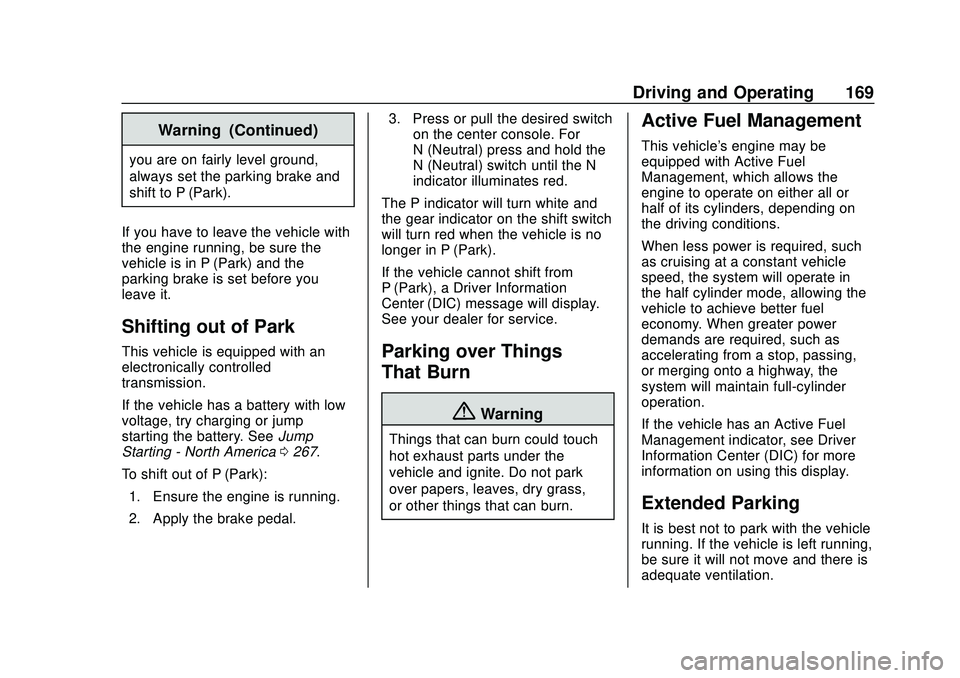
Chevrolet Corvette Owner Manual (GMNA-Localizing-U.S./Canada/Mexico-
12470550) - 2020 - CRC - 4/23/20
Driving and Operating 169
Warning (Continued)
you are on fairly level ground,
always set the parking brake and
shift to P (Park).
If you have to leave the vehicle with
the engine running, be sure the
vehicle is in P (Park) and the
parking brake is set before you
leave it.
Shifting out of Park
This vehicle is equipped with an
electronically controlled
transmission.
If the vehicle has a battery with low
voltage, try charging or jump
starting the battery. See Jump
Starting - North America 0267.
To shift out of P (Park):
1. Ensure the engine is running.
2. Apply the brake pedal. 3. Press or pull the desired switch
on the center console. For
N (Neutral) press and hold the
N (Neutral) switch until the N
indicator illuminates red.
The P indicator will turn white and
the gear indicator on the shift switch
will turn red when the vehicle is no
longer in P (Park).
If the vehicle cannot shift from
P (Park), a Driver Information
Center (DIC) message will display.
See your dealer for service.Parking over Things
That Burn
{Warning
Things that can burn could touch
hot exhaust parts under the
vehicle and ignite. Do not park
over papers, leaves, dry grass,
or other things that can burn.
Active Fuel Management
This vehicle's engine may be
equipped with Active Fuel
Management, which allows the
engine to operate on either all or
half of its cylinders, depending on
the driving conditions.
When less power is required, such
as cruising at a constant vehicle
speed, the system will operate in
the half cylinder mode, allowing the
vehicle to achieve better fuel
economy. When greater power
demands are required, such as
accelerating from a stop, passing,
or merging onto a highway, the
system will maintain full-cylinder
operation.
If the vehicle has an Active Fuel
Management indicator, see Driver
Information Center (DIC) for more
information on using this display.
Extended Parking
It is best not to park with the vehicle
running. If the vehicle is left running,
be sure it will not move and there is
adequate ventilation.
Page 172 of 336
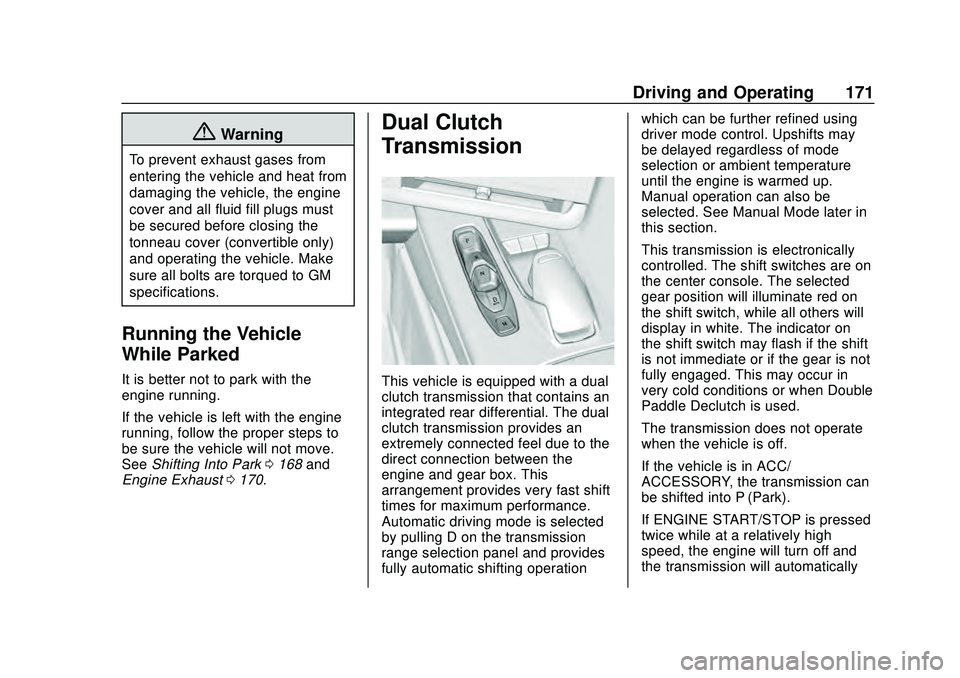
Chevrolet Corvette Owner Manual (GMNA-Localizing-U.S./Canada/Mexico-
12470550) - 2020 - CRC - 4/23/20
Driving and Operating 171
{Warning
To prevent exhaust gases from
entering the vehicle and heat from
damaging the vehicle, the engine
cover and all fluid fill plugs must
be secured before closing the
tonneau cover (convertible only)
and operating the vehicle. Make
sure all bolts are torqued to GM
specifications.
Running the Vehicle
While Parked
It is better not to park with the
engine running.
If the vehicle is left with the engine
running, follow the proper steps to
be sure the vehicle will not move.
SeeShifting Into Park 0168 and
Engine Exhaust 0170.
Dual Clutch
Transmission
This vehicle is equipped with a dual
clutch transmission that contains an
integrated rear differential. The dual
clutch transmission provides an
extremely connected feel due to the
direct connection between the
engine and gear box. This
arrangement provides very fast shift
times for maximum performance.
Automatic driving mode is selected
by pulling D on the transmission
range selection panel and provides
fully automatic shifting operation which can be further refined using
driver mode control. Upshifts may
be delayed regardless of mode
selection or ambient temperature
until the engine is warmed up.
Manual operation can also be
selected. See Manual Mode later in
this section.
This transmission is electronically
controlled. The shift switches are on
the center console. The selected
gear position will illuminate red on
the shift switch, while all others will
display in white. The indicator on
the shift switch may flash if the shift
is not immediate or if the gear is not
fully engaged. This may occur in
very cold conditions or when Double
Paddle Declutch is used.
The transmission does not operate
when the vehicle is off.
If the vehicle is in ACC/
ACCESSORY, the transmission can
be shifted into P (Park).
If ENGINE START/STOP is pressed
twice while at a relatively high
speed, the engine will turn off and
the transmission will automatically
Page 175 of 336
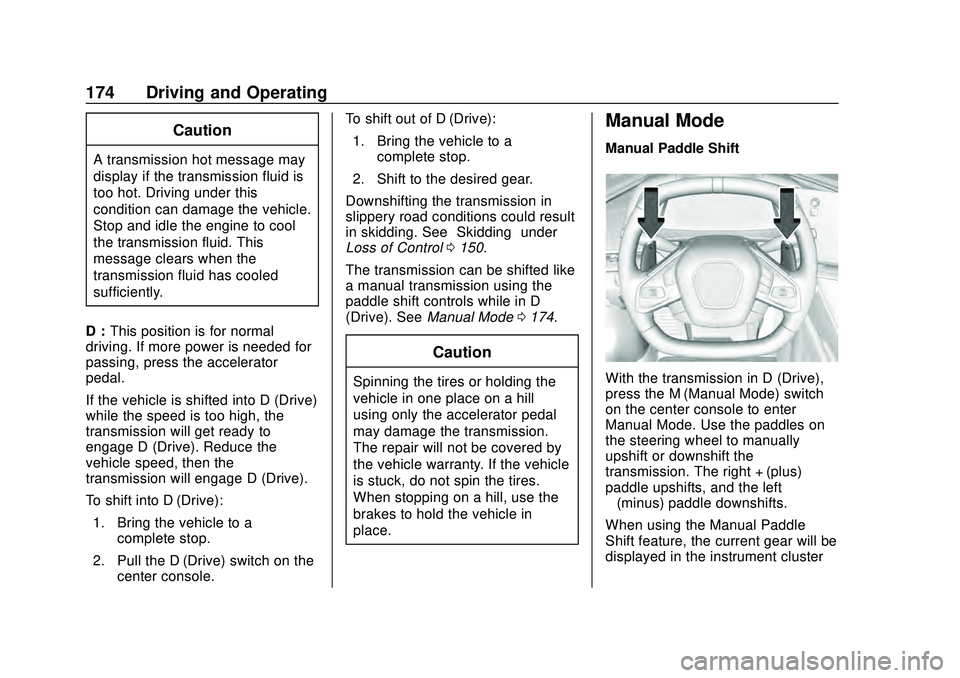
Chevrolet Corvette Owner Manual (GMNA-Localizing-U.S./Canada/Mexico-
12470550) - 2020 - CRC - 4/23/20
174 Driving and Operating
Caution
A transmission hot message may
display if the transmission fluid is
too hot. Driving under this
condition can damage the vehicle.
Stop and idle the engine to cool
the transmission fluid. This
message clears when the
transmission fluid has cooled
sufficiently.
D : This position is for normal
driving. If more power is needed for
passing, press the accelerator
pedal.
If the vehicle is shifted into D (Drive)
while the speed is too high, the
transmission will get ready to
engage D (Drive). Reduce the
vehicle speed, then the
transmission will engage D (Drive).
To shift into D (Drive):
1. Bring the vehicle to a complete stop.
2. Pull the D (Drive) switch on the center console. To shift out of D (Drive):
1. Bring the vehicle to a complete stop.
2. Shift to the desired gear.
Downshifting the transmission in
slippery road conditions could result
in skidding. See “Skidding”under
Loss of Control 0150.
The transmission can be shifted like
a manual transmission using the
paddle shift controls while in D
(Drive). See Manual Mode 0174.
Caution
Spinning the tires or holding the
vehicle in one place on a hill
using only the accelerator pedal
may damage the transmission.
The repair will not be covered by
the vehicle warranty. If the vehicle
is stuck, do not spin the tires.
When stopping on a hill, use the
brakes to hold the vehicle in
place.
Manual Mode
Manual Paddle Shift
With the transmission in D (Drive),
press the M (Manual Mode) switch
on the center console to enter
Manual Mode. Use the paddles on
the steering wheel to manually
upshift or downshift the
transmission. The right + (plus)
paddle upshifts, and the left
−(minus) paddle downshifts.
When using the Manual Paddle
Shift feature, the current gear will be
displayed in the instrument cluster
Page 176 of 336
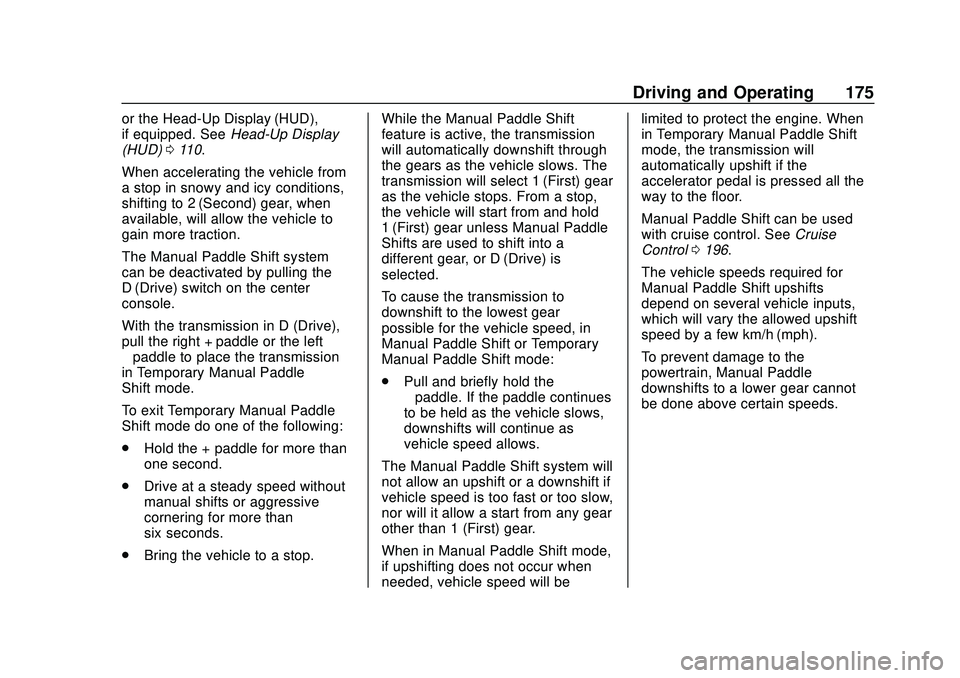
Chevrolet Corvette Owner Manual (GMNA-Localizing-U.S./Canada/Mexico-
12470550) - 2020 - CRC - 4/23/20
Driving and Operating 175
or the Head-Up Display (HUD),
if equipped. SeeHead-Up Display
(HUD) 0110.
When accelerating the vehicle from
a stop in snowy and icy conditions,
shifting to 2 (Second) gear, when
available, will allow the vehicle to
gain more traction.
The Manual Paddle Shift system
can be deactivated by pulling the
D (Drive) switch on the center
console.
With the transmission in D (Drive),
pull the right + paddle or the left
− paddle to place the transmission
in Temporary Manual Paddle
Shift mode.
To exit Temporary Manual Paddle
Shift mode do one of the following:
. Hold the + paddle for more than
one second.
. Drive at a steady speed without
manual shifts or aggressive
cornering for more than
six seconds.
. Bring the vehicle to a stop. While the Manual Paddle Shift
feature is active, the transmission
will automatically downshift through
the gears as the vehicle slows. The
transmission will select 1 (First) gear
as the vehicle stops. From a stop,
the vehicle will start from and hold
1 (First) gear unless Manual Paddle
Shifts are used to shift into a
different gear, or D (Drive) is
selected.
To cause the transmission to
downshift to the lowest gear
possible for the vehicle speed, in
Manual Paddle Shift or Temporary
Manual Paddle Shift mode:
.
Pull and briefly hold the
−paddle. If the paddle continues
to be held as the vehicle slows,
downshifts will continue as
vehicle speed allows.
The Manual Paddle Shift system will
not allow an upshift or a downshift if
vehicle speed is too fast or too slow,
nor will it allow a start from any gear
other than 1 (First) gear.
When in Manual Paddle Shift mode,
if upshifting does not occur when
needed, vehicle speed will be limited to protect the engine. When
in Temporary Manual Paddle Shift
mode, the transmission will
automatically upshift if the
accelerator pedal is pressed all the
way to the floor.
Manual Paddle Shift can be used
with cruise control. See
Cruise
Control 0196.
The vehicle speeds required for
Manual Paddle Shift upshifts
depend on several vehicle inputs,
which will vary the allowed upshift
speed by a few km/h (mph).
To prevent damage to the
powertrain, Manual Paddle
downshifts to a lower gear cannot
be done above certain speeds.
Page 181 of 336
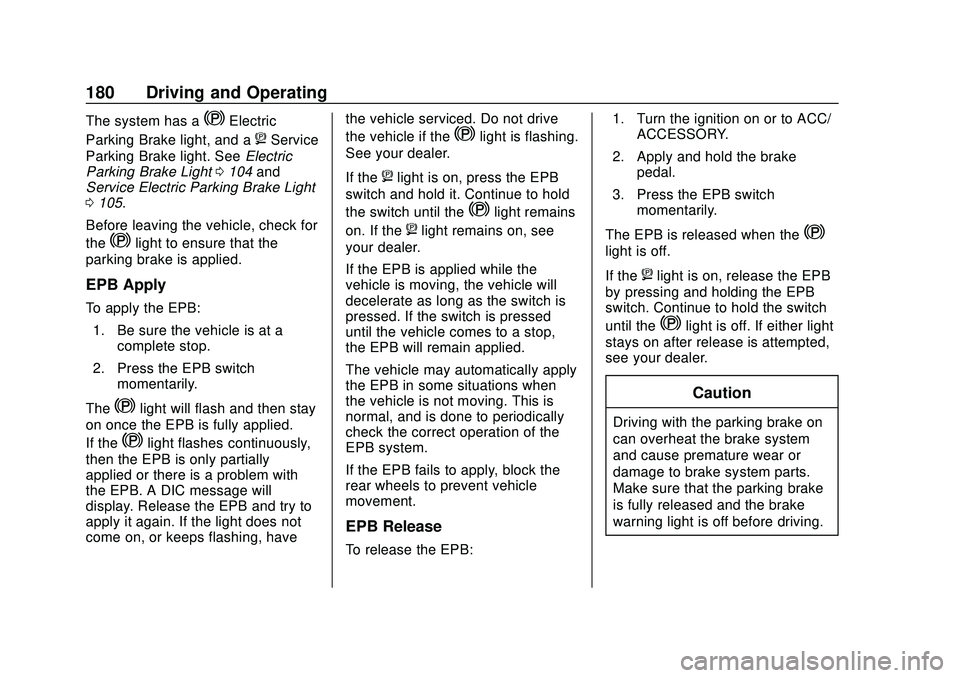
Chevrolet Corvette Owner Manual (GMNA-Localizing-U.S./Canada/Mexico-
12470550) - 2020 - CRC - 4/23/20
180 Driving and Operating
The system has aYElectric
Parking Brake light, and a
8Service
Parking Brake light. See Electric
Parking Brake Light 0104 and
Service Electric Parking Brake Light
0 105.
Before leaving the vehicle, check for
the
Ylight to ensure that the
parking brake is applied.
EPB Apply
To apply the EPB:
1. Be sure the vehicle is at a complete stop.
2. Press the EPB switch momentarily.
The
Ylight will flash and then stay
on once the EPB is fully applied.
If the
Ylight flashes continuously,
then the EPB is only partially
applied or there is a problem with
the EPB. A DIC message will
display. Release the EPB and try to
apply it again. If the light does not
come on, or keeps flashing, have the vehicle serviced. Do not drive
the vehicle if the
Ylight is flashing.
See your dealer.
If the
8light is on, press the EPB
switch and hold it. Continue to hold
the switch until the
Ylight remains
on. If the
8light remains on, see
your dealer.
If the EPB is applied while the
vehicle is moving, the vehicle will
decelerate as long as the switch is
pressed. If the switch is pressed
until the vehicle comes to a stop,
the EPB will remain applied.
The vehicle may automatically apply
the EPB in some situations when
the vehicle is not moving. This is
normal, and is done to periodically
check the correct operation of the
EPB system.
If the EPB fails to apply, block the
rear wheels to prevent vehicle
movement.
EPB Release
To release the EPB: 1. Turn the ignition on or to ACC/
ACCESSORY.
2. Apply and hold the brake pedal.
3. Press the EPB switch momentarily.
The EPB is released when the
Y
light is off.
If the
8light is on, release the EPB
by pressing and holding the EPB
switch. Continue to hold the switch
until the
Ylight is off. If either light
stays on after release is attempted,
see your dealer.
Caution
Driving with the parking brake on
can overheat the brake system
and cause premature wear or
damage to brake system parts.
Make sure that the parking brake
is fully released and the brake
warning light is off before driving.